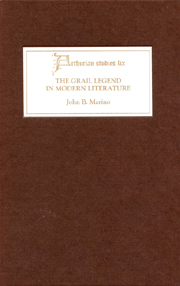Book contents
1 - The Medieval Texts
Published online by Cambridge University Press: 12 September 2012
Summary
Chrétien de Troyes's Perceval
The earliest extant Grail text is Chrétien de Troyes's unfinished late-twelfth-century Old French verse Perceval or Le Conte du Graal. Charles Potvin published the first modern edition of the text from 1866 to 1871 in a six-volume edition, which also contains the works of Chrétien's continuators, the Elucidation and the Perlesvaus. Perceval was translated into English by Robert W. Linker in 1952. Previously, William Wells Newell had published a close translation in his King Arthur and the table round: tales chiefly after the Old French of Crestien of Troyes, with an account of Arthurian romance, and notes (1897).
The early Grail texts, those of Chrétien and his direct followers, have Perceval as the hero of the quest and not Galahad, who we know to be the hero through Malory's fifteenth-century prose Le Morte D'Arthur. So the modern editions of these earlier texts introduced an alternative quest. At the earliest known stage of the legend, Chrétien does not tell us much about what the Grail is or how it got where it is. His text is not insistent about any ideology or religious associations, as Malory's text and his source are, although in the late-twelfth- to early-thirteenthcentury continuations of Chrétien's unfinished poem the Grail is Christianized. But for Chrétien a graal, a radiant jeweled dish, at first mention not even said to be the one and only graal, and a lance which drips blood are not particularly Christian.
- Type
- Chapter
- Information
- The Grail Legend in Modern Literature , pp. 15 - 27Publisher: Boydell & BrewerPrint publication year: 2004



